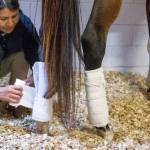Support Wound Healing with Omega-3 Fatty Acids

Speak to any experienced horseperson and they will share their struggles associated with managing wounds on the lower limbs. Often caked with dirt and debris by the time they are discovered, setting the stage for infection, these wounds can be expensive to treat. Further, limited tissue often precludes closing the wound fully with stitches, and excessively enthusiastic healing attempts by the body can produce proud flesh, which inhibits healing.
“Wound healing is a carefully orchestrated process involving many inflammatory mediators that direct the ‘flow of traffic.’ These mediators tell skin and blood cells where to go during the repair and regeneration phases and help fight infection,” explained Kathleen Crandell, Ph.D., a Kentucky Equine Research nutritionist.
Veterinarians have tried multiple approaches in an effort to expedite wound-healing with aesthetically pleasing and functional outcomes: soaps and salves, antibiotic-impregnated bandage materials, placental dressings, manuka honey, hyperbaric oxygen chambers, and fly larvae.
“Evidence also exists that dietary omega-3 fatty acids can exert anti-inflammatory effects, attenuate systemic inflammation, and may decrease susceptibility to wound infections,” Crandell relayed.
Like other fields of equine medicine, more research is certainly needed to determine the exact role of omega-3 fatty acids in wound healing. Given the benefits associated with omega-3 supplementation and the safety profile of these products, exploring this avenue of wound management appeals to horse owners.
“EO-3, developed by Kentucky Equine Research, is a palatable marine-derived source of the omega-3 fatty acids DHA and EPA. In addition, biotin supplementation may support wound healing,” advised Crandell.








